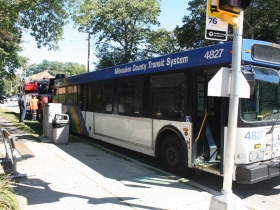Transportation Policy Rarely Protects Civil Rights
Because civil rights laws lack teeth, most highways get built regardless of impact on minorities.

Wisconsin is sinking billions into highway expansion projects while city transit service languishes.
American transportation policy has a woeful history of civil rights abuses. For a good part of the 1950s and ’60s, using highways to level black neighborhoods was a matter of national policy. And the white flight and segregation that those highways engendered have left a legacy that continues to shape much of America in the present day.
Out of those chapters in American history came a few key protections. Laws like Title VI of the Civil Rights Act aim to safeguard people from discrimination by federally-funded agencies.
But are these protections shaping a fairer transportation system? Not according to a recent study by researchers at the University of California-Davis published in the Journal of Transport Geography [PDF]. Authors Alex Karner and Deb Niemeier say that most metropolitan planning agencies are simply going through the motions, not making equitable decisions.
Right now, “basically anything goes,” Karner told Streetsblog. “You can make anything look good from a civil rights perspective” under current law, using conventional metrics to demonstrate compliance.
As a last resort, civil rights activists can use federal laws to take action in court. Black and Hispanic community groups in Wisconsin, for instance, are suing the state Department of Transportation under the National Environmental Policy Act for shortchanging transit with the $1.7 billion Zoo Interchange project, outside Milwaukee. But Karner and Niemeier say the whole federally-required “equity analysis” process needs to be reformed if it is to have a meaningful effect on decision making.
Here’s what Karner and Niemeier recommend to give civil rights protections some real teeth when it comes to transportation investments:
1. Perform Equity Analyses Early in the Planning Process
Metropolitan planning organizations, or MPOs, are agencies that play a big role in distributing federal transportation dollars. They generally decide what they want to do first, then spend a lot of time developing plans, and then at the very end perform the required equity analysis.
“After all the major planning decisions have been made, it’s a pro forma thing,” says Karner. “They just kind of check a box.”
Karner and Niemeier say in order to meaningfully advance equity, it’s important to consider who will be affected very early in the planning stages or — better yet — in the project selection phase.
Most MPOs begin equity analyses by examining “communities of concern,” or geographic areas that have a concentration of low-income or minority households. This is less than ideal, Karner says, because poor people and people of color living outside those areas are ignored for the purposes of the study.
Additionally, MPOs do not typically consider race as a factor in transportation modeling, even though they track a range of demographic characteristics like household income.
3. Positive Projections Obscure Current Inequalities
Planning processes require agencies to project decades into the future, to predict things like air quality impacts and traffic volumes. But predicting what will happen 20 years from now requires a great deal of guesswork, and assumptions made by planners about the long run can mask real effects in the present day.
“The forecasts always show things getting better,” said Karner. “In these conditions it’s very easy to show that it’s equitable — everyone is better off.”
What advocates for low-income and minority groups in the Bay Area have requested is that planning agencies take a closer look at current and near-term conditions, which can offer more meaningful insights.
The Federal Role
Karner said he isn’t optimistic that MPOs will reform these practices on their own. Many MPOs fear that changing the way they measure equity could make them vulnerable to litigation, if the new method shows past investments were distributed unfairly.
A more hopeful scenario is that U.S. DOT will become “more prescriptive” with the way it handles the issue, Karner says. Currently, the federal government forbids discrimination but is extremely vague about what transportation agencies must do to avoid running afoul of the law. The Federal Highway Administration, for example, does not specify how agencies “should assess the incidence of benefit and burden” with respect to protected groups.
The usual result, Karner and Niemeier write, is that any equity analysis completed by MPOs “is considered sufficient for compliance.”
Story by Angie Schmitt with additional contributions from Urban Milwaukee. A version of this story originally ran on Streetsblog. Angie Schmitt is a newspaper reporter-turned planner/advocate who manages the Streetsblog Network from glamorous Cleveland, Ohio. She also writes about urban issues particular to the industrial Midwest at Rustwire.com.
Streetsblog
-
Car Culture Cements Suburban Politics
![Sprawl. Photo by David Shankbone (David Shankbone) [GFDL (http://www.gnu.org/copyleft/fdl.html) or CC-BY-SA-3.0 (http://creativecommons.org/licenses/by-sa/3.0/)], via Wikimedia Commons [ https://commons.wikimedia.org/wiki/File%3ASuburbia_by_David_Shankbone.jpg ]](https://urbanmilwaukee.com/wp-content/uploads/2017/10/1024px-Suburbia_by_David_Shankbone-185x122.jpg) Nov 23rd, 2018 by Angie Schmitt
Nov 23rd, 2018 by Angie Schmitt
-
Most Drivers Don’t Yield to Pedestrians
 Mar 22nd, 2018 by Angie Schmitt
Mar 22nd, 2018 by Angie Schmitt
-
Jobs Up Yet Driving Down in Seattle
 Feb 22nd, 2018 by Angie Schmitt
Feb 22nd, 2018 by Angie Schmitt


















